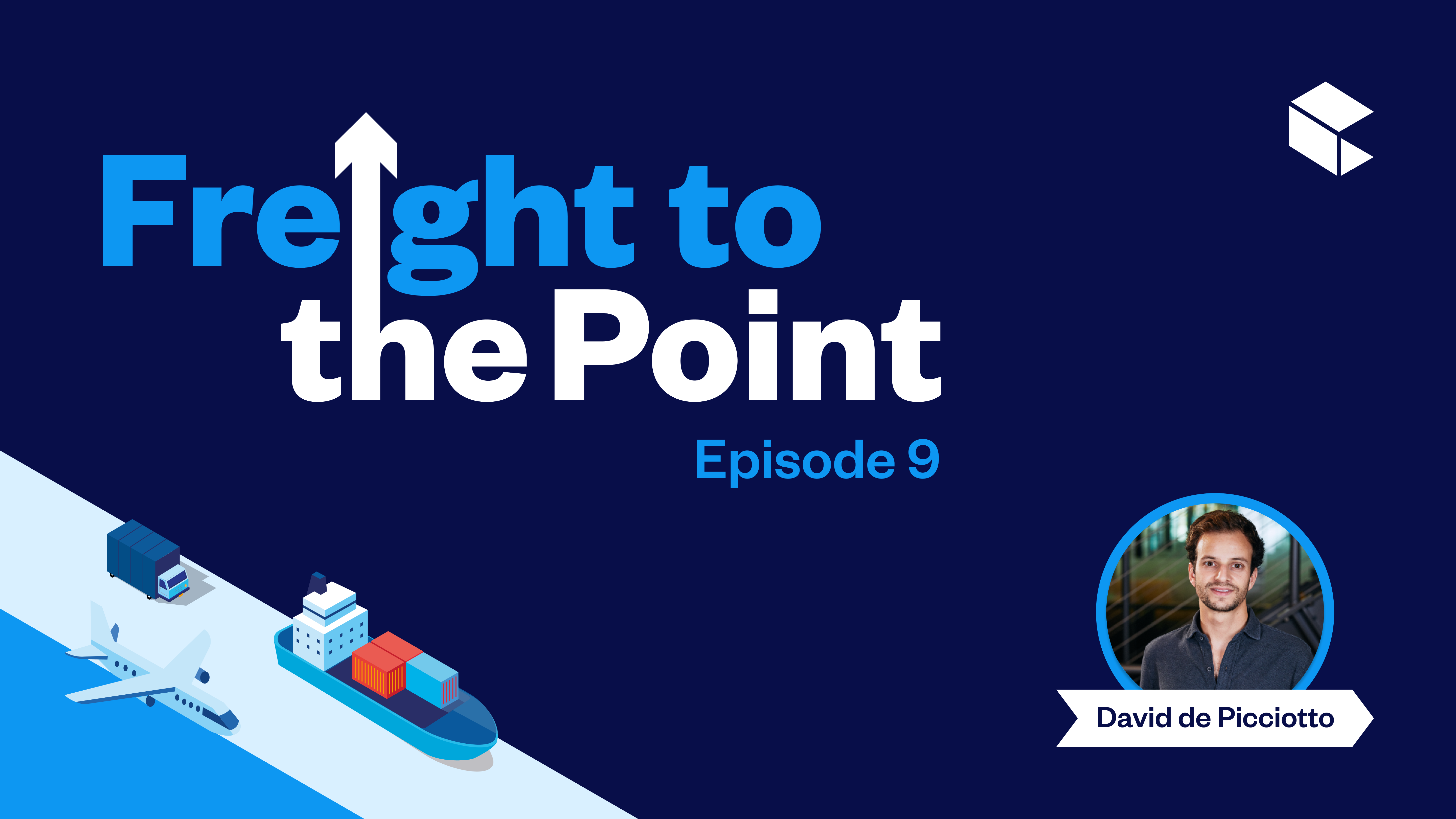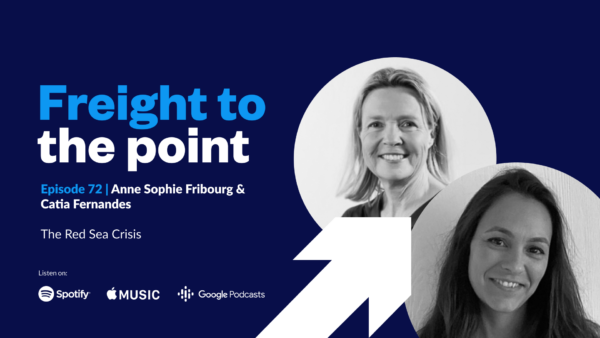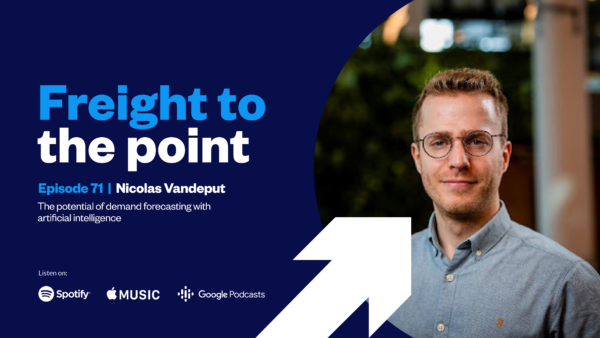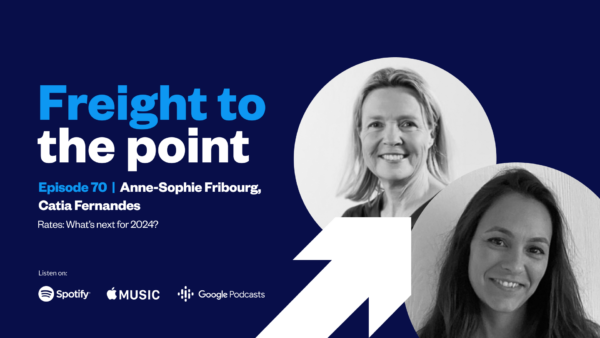Episode 9:
Sustainability in the supply chain with David de Picciotto
See all episodes

Are businesses doing enough to make their supply chains more sustainable?
Find out more in this episode of Freight to the Point as Helena Wood is joined by David de Picciotto, CEO and Co-Founder of Pledge. Pledge provides tools and infrastructure to allow businesses to measure their carbon impact on their environment with a focus on the supply chain. This year, Zencargo and Pledge have worked together to offer businesses SKU visibility across shipments, and giving them an instant view on emissions in their supply chain.
This episode explores:
- Why businesses should prioritise sustainability in their agendas
- The business benefits of having a sustainable supply chain
- The value of data when looking at supply chain emissions
Resources
Zencargo partners with Pledge – https://www.zencargo.com/resources/zencargo-partners-with-pledge/
How data can help you lower carbon emissions in your supply chain – https://www.zencargo.com/resources/how-data-can-help-you-lower-carbon-emissions-in-your-supply-chain/
 Hello, and welcome to Episode Nine of Freight to the Point, a podcast by Zencargo. I’m Helena Wood, and today I am joined by David de Picciotto, the co-founder of Pledge, a company which offers a dedicated climate infrastructure platform to help businesses integrate carbon measurement and offsetting tools into their customer experience. Welcome, David. It’s absolutely great to have you with us.
Hello, and welcome to Episode Nine of Freight to the Point, a podcast by Zencargo. I’m Helena Wood, and today I am joined by David de Picciotto, the co-founder of Pledge, a company which offers a dedicated climate infrastructure platform to help businesses integrate carbon measurement and offsetting tools into their customer experience. Welcome, David. It’s absolutely great to have you with us.

 Pledge and Zencargo have been working together for a few months now. Would you like to tell our listeners a little bit about the great work we’re doing together?
Pledge and Zencargo have been working together for a few months now. Would you like to tell our listeners a little bit about the great work we’re doing together?

 Very excited to be in partnership with you guys. I think there’s some amazing work that we’re already doing. David, let’s get freight to the point. Tell us how you came to start Pledge, and how you started looking at making an impact in the supply chain space.
Very excited to be in partnership with you guys. I think there’s some amazing work that we’re already doing. David, let’s get freight to the point. Tell us how you came to start Pledge, and how you started looking at making an impact in the supply chain space.
I’ve been working in the world of startups as an operator, but also as an investor, for the past few years. Starting my first company when I was in college, and then joined, back in the days, a UK fintech called Revolut, before switching to the investment side. I work in a private investment firm. At the end of that last experience, there was the convergence of three events.
One was the motivation to solve big problems. The second one was just the tailwind I saw in the sustainability space. And finally, the tipping point, which was working in this private investment firm, and sitting actually right next to the ESG team, I saw firsthand how increasingly important ESG KPIs were becoming for investors, specifically for LPs of these funds, such as pension funds, and how difficult it was to track these KPIs at the company level.
Based on my past startup experience, I thought that’s a great use case for software, to help streamline things and lower bars to adoption for these companies. Alongside a couple of colleagues and friends that I met during my time at Revolut, we teamed up to build this platform, which helps businesses understand and manage the climate impact. When we looked at where do we need the most help right now, we started looking at high-emitting industries, and transportation at large, with obviously supply chain transportation being an aggregate responsible for around a fifth globally.

 Super. It’s so interesting. I think the angle of coming into the sustainability space from almost taking the investor perspective, I wonder whether or not, David, you found from your experience, do you think that it opens a different type of sustainability conversation with the customers that you work with? Or do you think that the investor angle strengthens the argument because of the background and the credibility that you have?
Super. It’s so interesting. I think the angle of coming into the sustainability space from almost taking the investor perspective, I wonder whether or not, David, you found from your experience, do you think that it opens a different type of sustainability conversation with the customers that you work with? Or do you think that the investor angle strengthens the argument because of the background and the credibility that you have?
I think it really depends who you speak to in a company. If you will speak to the management of the company, they will most likely and increasingly so get pressure from their investors to develop a sustainability strategy and ideally align with specific SBTi goals and maybe develop a net zero target or strategy.

 Makes a lot of sense. You’re totally right in calling out supply chain, and supply chain and businesses as some of the guiltier parties in the global emissions crisis, naturally, given the scale of supply chain and given the nature of the industry. But I suppose from what you’ve seen, David, do you think supply chain leaders are doing enough to be sustainable?
Makes a lot of sense. You’re totally right in calling out supply chain, and supply chain and businesses as some of the guiltier parties in the global emissions crisis, naturally, given the scale of supply chain and given the nature of the industry. But I suppose from what you’ve seen, David, do you think supply chain leaders are doing enough to be sustainable?

 And do you think it’s a perception that moving to being a more sustainable business is hard? Is that why it often falls lower in the agenda? Or do you think it’s often just overtaken by other priorities?
And do you think it’s a perception that moving to being a more sustainable business is hard? Is that why it often falls lower in the agenda? Or do you think it’s often just overtaken by other priorities?
From discussing with varying customer sizes from very large enterprises, to even the small-scale freight forwarders who may be zero to 100 FTE, what we found is that there are two criteria amongst others that stand out. The first one is trust. If I launch a sustainability initiative, how do I make sure that I’m not greenwashing, or fall into the risk of greenwashing? That also comes from the fact that there’s not a lot of education today in the industry. So, how do you demonstrate trust? And in that context, for example, at Pledge, we demonstrate trust through an accreditation we’ve received for the calculation. And that we compute.

 That makes a lot of sense. What do you think we can do, maybe coming from the Pledge angle, or possibly collectively, to help these businesses prioritise sustainability? You’ve spoken about a platform. Are there other things that could make things easier?
That makes a lot of sense. What do you think we can do, maybe coming from the Pledge angle, or possibly collectively, to help these businesses prioritise sustainability? You’ve spoken about a platform. Are there other things that could make things easier?
I think if you look at the industry today, you mostly have the large companies who have launched sustainability initiatives alongside the next gen forwarders, who are also early adopters. Ultimately, the push is coming from the shippers. If you look at freight forwarders catering to the retail or FMCG industry, you may see a greater incentive to adopt sustainability tools or to launch sustainability initiatives.

 I think something that rings true in what you’re saying as well is, from a Zencargo perspective, we definitely see there’s variance between how different brands approach sustainability. And definitely on the frontline of consumer focus retail, there’s sensitivity to consumers who are, frankly, much more focused on sustainable choices nowadays, but who naturally still want their goods as quickly as possible and as cheaply as possible. I can completely understand why so many shippers at the moment are really feeling that pinch because it often, I think, feels like a give, take relationship with sustainability. Often sustainability, unfortunately, falls off the scale.
I think something that rings true in what you’re saying as well is, from a Zencargo perspective, we definitely see there’s variance between how different brands approach sustainability. And definitely on the frontline of consumer focus retail, there’s sensitivity to consumers who are, frankly, much more focused on sustainable choices nowadays, but who naturally still want their goods as quickly as possible and as cheaply as possible. I can completely understand why so many shippers at the moment are really feeling that pinch because it often, I think, feels like a give, take relationship with sustainability. Often sustainability, unfortunately, falls off the scale.
The most important one is that, it helps businesses gain a competitive advantage. And this is demonstrated three ways. One is, it helps them win new business. Because today, again, coming from the shipper’s angle, there’s an increasing amount of tenders where just to participate in a tender, you need to have a sustainability offering because this is something that the shipper will need for the reporting.
Second thing is, even with existing clients, and we’ve seen this with a few customers, it can help them increase share of wallet with existing shippers. If a shipper has a relationship with different forwarders, they may decide to shift 100% or an increasing percentage of their freight with a specific provider. Because again, they may have a reporting obligation and so they rather want to have consistent data across one provider that can provide them this emission shipment level of visibility.

 Which is important. It’s a really important point, that final thing around… I think we also see not only our consumers demanding nowadays, but our employees and the people that we work with, I would like to say myself included. We want to work with businesses and in businesses that are thinking about their emissions, that are thinking about the role they play in the wider environmental conversation.
Which is important. It’s a really important point, that final thing around… I think we also see not only our consumers demanding nowadays, but our employees and the people that we work with, I would like to say myself included. We want to work with businesses and in businesses that are thinking about their emissions, that are thinking about the role they play in the wider environmental conversation.

 That makes a lot of sense. And I’m interested to then think about the relationship between a sustainability focus or being able to bring sustainability into your role for supply chain leaders. Often in this podcast, we talk about the role of the supply chain leader in a business.
That makes a lot of sense. And I’m interested to then think about the relationship between a sustainability focus or being able to bring sustainability into your role for supply chain leaders. Often in this podcast, we talk about the role of the supply chain leader in a business.
Something that we at Zencargo really want to advocate for is, taking supply chain from the back office to the boardroom and really helping supply chain leaders earn a seat to the table. Because we know, and we can see with so many of our customers, that within businesses that optimise their supply chain, the outcomes and the fruits of those labours are felt across the business. Whether that might be in retail revenue, whether it might be in business growth, whether it might be in working capital management, there are so many areas of the business that can be impacted by this.
I have a few thoughts. I think, as you’ve echoed, supply chain have a significant impact for both businesses and the environment. And as a result of that, leaders within this organisation are facing new, external through shippers and maybe regulators, but also internal, for employees, a demand for sustainability. And if we maybe take a step back and look at ourselves as consumers, we’ve been living in the world of just-in-time delivery, of when you press that button at the checkout of an e-commerce platform, you get the pair of shoe the next day. You do that without really thinking about the environmental impact, but it definitely has a massive impact.
I think for bringing sustainability initiatives, for example, if a shipper is presented at the quoting stage, different shipping options, and you can maybe now with tools like Pledge surface, what is the greenest route to take, although it may take a little bit longer. For example, if you switch your mode of transport from air to sea, surfacing these insights can help drive action. Not only you then be able to satisfy your external stakeholder demand, but also to raise awareness internally, amongst your employees. That’s one example.
And then another practical example that we’ve come across, actually, we talked to a logistics company, to a sales leader within that organisation, for whom sustainability wasn’t in the agenda. The person took the call with us. We’ve explained them how this is becoming increasingly important for shippers and how, through tools like Pledge, they could help gain a competitive advantage and eventually win new tenders. That person decided to trial our product. And then as a result of that, landed a new client.

 That’s a pretty powerful case study for you guys, and for anyone that’s listening, because I’d love to give you the spotlight to talk about this. Could you give us, maybe, a working case study or a working example of what using Pledge looks like within a business who are focusing on the sustainability data in their supply chain?
That’s a pretty powerful case study for you guys, and for anyone that’s listening, because I’d love to give you the spotlight to talk about this. Could you give us, maybe, a working case study or a working example of what using Pledge looks like within a business who are focusing on the sustainability data in their supply chain?
Sure. I think Zencargo is a great example. If you think about Zencargo, the way we’ve worked together is that, Zencargo has access to all the relevant shipment data on behalf of their customer.
What they’re doing is, they’re integrating the Pledge calculator and offsetting solution to provide a detailed, granular calculation output on a shipment-by-shipment level, and then surfacing these insights for the shippers in the Zencargo dashboard. And then through that process then, you’ll be able to understand where the hotspots are among these emissions, how they’re distributed across, maybe, different mode of transport, across, maybe, carriage.

 It’s a great work through. And I think we know a lot of examples, David, of businesses that are using this. If I think of a particular example, as a Zencargo customer, I know this is a business who’s very focused on sustainability within their decision making, and everything within their ethos as a business, and having access to the data, to identify hotspots and then also to take calculated risks. I think this is the reality for supply chain leaders. Sometimes air freight isn’t necessary evil. If we want to move goods very quickly, sometimes they need to go on a plane.
It’s a great work through. And I think we know a lot of examples, David, of businesses that are using this. If I think of a particular example, as a Zencargo customer, I know this is a business who’s very focused on sustainability within their decision making, and everything within their ethos as a business, and having access to the data, to identify hotspots and then also to take calculated risks. I think this is the reality for supply chain leaders. Sometimes air freight isn’t necessary evil. If we want to move goods very quickly, sometimes they need to go on a plane.
But if you’ve got much better insight as to what’s going on across your whole supply chain and you’re optimising, let’s say maybe 80 to 90% of it by making sensible decisions, using great data, you can then make much more educated decisions about when and where you’re willing to possibly forgo the most sustainable choice, perhaps in favour of meeting consumer demand or filling your warehouse, when it’s starting to get low.
I wonder if we can change tact and start talking a little bit about offsetting, and talking also about what comes next. I’d love to hear, David, from your expertise, what do you think the future might look like for shippers who start to gain visibility and awareness of the sustainability of their supply chain, maybe optimise their supply chain based on that data and that understanding, and then come to think about what to do next. There’s always going to be emissions related to supply chain. And businesses may or may not choose to look at offsetting as a way to counter those emissions. What are your recommendations or your thoughts?
To set the context, when you think about a sustainability journey, which ultimately is driven not only by collective pressure, but also will increasingly so be driven by regulations, there’s essentially a three-step journey. The first one is that, you need to measure your emission. Because you can’t hit your industry targets and reducing emissions, if you don’t start measuring them. So really, the first step is about understanding the data that’s available. If you have data gaps, how can you get that missing data to then build this first picture of your emission?
The second step is about then, reducing these emissions. What initiative do you have in place, be it for the use of more fuel-efficient routes, different mode of transport, even potentially biofuel as a sustainable aviation fuel? How can you start reducing these emissions and doing it over a long period of time with a clear strategy?
And then finally, because in transportation, the best way to not emit is to not execute the shipment, you will likely always have some form of residual emission, even if you use electric vehicle or others. And this is where potentially offsetting can then help you hit your net zero targets. And when we think about offsetting, there’s generally two categories that we can think of.
 |
 That’s really interesting. I think you’re totally right. I would imagine many people, when they think of offsetting, immediately go to tree planting. But knowing that there are so many other options available… And I’m going to make a hypothetical guess here which may be totally wrong… possibly more scalable solutions within that scientific field, there’s hopefully a lot more scope for businesses to think about how they can contribute to offsetting even those residual emissions.
That’s really interesting. I think you’re totally right. I would imagine many people, when they think of offsetting, immediately go to tree planting. But knowing that there are so many other options available… And I’m going to make a hypothetical guess here which may be totally wrong… possibly more scalable solutions within that scientific field, there’s hopefully a lot more scope for businesses to think about how they can contribute to offsetting even those residual emissions.

 I’m really pleased you brought that up because I was actually about to ask about it, which is… Something that comes up a lot, though many businesses and many individuals within businesses are incredibly well-intended around making sustainable choices and working towards sustainability, not only let’s talk about their supply chain, but it might even be in the day-to-day operation of their business, their travel policies, how they think about how they run their office, and greenwashing comes up.
I’m really pleased you brought that up because I was actually about to ask about it, which is… Something that comes up a lot, though many businesses and many individuals within businesses are incredibly well-intended around making sustainable choices and working towards sustainability, not only let’s talk about their supply chain, but it might even be in the day-to-day operation of their business, their travel policies, how they think about how they run their office, and greenwashing comes up.
It comes up because, I think, a lot of businesses are very nervous about their well-intentioned actions being misinterpreted, or people poking holes in other parts of a business. Because, of course, there’s such a complex web of all the different ways in which our actions, the way we run our businesses, the choices we make in our business, contribute to the sustainability footprint of our companies and us as individuals.
What would you say to someone who is really nervous about that fear of being pointed out for greenwashing, and almost unable to act because of that anxiety?

 I think that’s a really powerful answer. Data certainly helps unlock a lot of things. It’s a huge defense if you’re nervous about how something might be interpreted, to always be able to show your workings, as it were, with your data.
I think that’s a really powerful answer. Data certainly helps unlock a lot of things. It’s a huge defense if you’re nervous about how something might be interpreted, to always be able to show your workings, as it were, with your data.
David, one final question for you, before we move on to our quickfire round. This is something we ask everyone that we speak to on the podcast. I’d love to hear your vision for the future of supply chain, but specifically because of your expertise in the context of this conversation, I’d love to hear your vision for the future of the relationship between supply chain and sustainability.

 Let’s hope we can get there. I wonder how long it will take?
Let’s hope we can get there. I wonder how long it will take?
Probably a couple of years.

 Only a couple of years. I might hold you to that. I’d love to come back and do this podcast in two years time, and I really hope we’re measurably closer.
Only a couple of years. I might hold you to that. I’d love to come back and do this podcast in two years time, and I really hope we’re measurably closer.

 David, I hope you’re sitting comfortably. It is time for our quickfire question round. We go through this with all of our guests on the podcast. First question for you, David.
David, I hope you’re sitting comfortably. It is time for our quickfire question round. We go through this with all of our guests on the podcast. First question for you, David.

 That would be a lot of fun. Which industry would you love Pledge to start working with next?
That would be a lot of fun. Which industry would you love Pledge to start working with next?

 Perfect. One last question, what’s the number one lesson that your exposure to the supply chain space has taught you?
Perfect. One last question, what’s the number one lesson that your exposure to the supply chain space has taught you?

 It’s a pretty good summary. I definitely feel the same way. I think it’s got a lot of scope for some really interesting transformation. Super. David, thank you so much for joining us today on Freight to the Point. We’ve so enjoyed hearing from you and hearing more about Pledge.
It’s a pretty good summary. I definitely feel the same way. I think it’s got a lot of scope for some really interesting transformation. Super. David, thank you so much for joining us today on Freight to the Point. We’ve so enjoyed hearing from you and hearing more about Pledge.

 Not at all, it’s been great fun. And thank you also to all of our listeners who have tuned in for this week’s episode. Don’t forget to like, review and subscribe to our podcast. And if you have any feedback on today’s episode, would like to get in touch with David to learn more about Pledge, or have any questions, please do get in touch with us. You can find us on LinkedIn.
Not at all, it’s been great fun. And thank you also to all of our listeners who have tuned in for this week’s episode. Don’t forget to like, review and subscribe to our podcast. And if you have any feedback on today’s episode, would like to get in touch with David to learn more about Pledge, or have any questions, please do get in touch with us. You can find us on LinkedIn.

Episode 72: The Red Sea Crisis
In the latest episode of Freight to the Point, we’ve featured our most rec...

Episode 71: The potential of demand forecasting with artificial intelligence
In the most recent instalment of Freight to the Point, Lucie Phillips, Zen...

Episode 70: Rates: What's next for 2024?
As we prepare for the year ahead, it's crucial to consider the three pillars...

